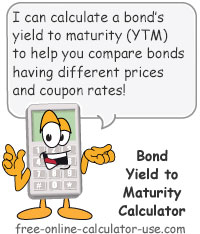IMPORTANT: Numeric entry fields must not contain dollar signs, percent signs, commas, spaces, etc. (only digits 0-9 and decimal points are allowed).
Click the Terms tab above for a more detailed description of each entry.
Step #1:
Enter current price of the bond.
Step #2:
Enter the par (face) value of the bond.
Step #3:
Enter the bond's coupon rate percentage.
Step #4:
Enter the number of years until the bond reaches maturity.
Step #5:
Click the "Calculate Yield to Maturity" button, which will display the information you will need to compare the entered bond with those that have different maturities, prices, and coupon rates.


Follow me on any of the social media sites below and be among the first to get a sneak peek at the newest and coolest calculators that are being added or updated each month.